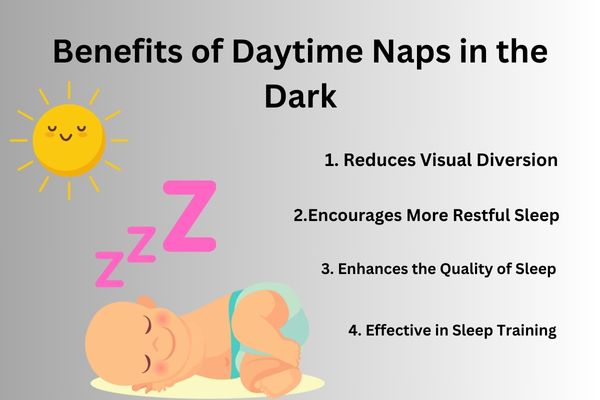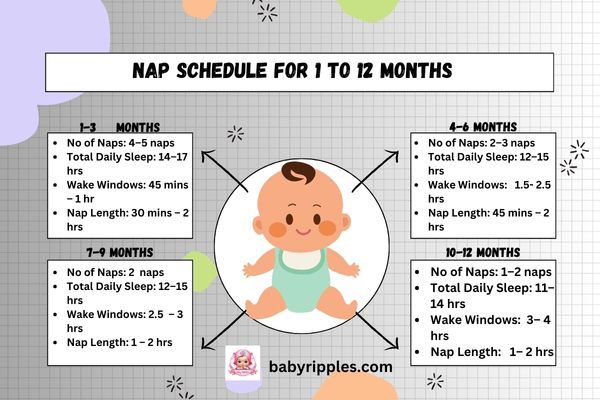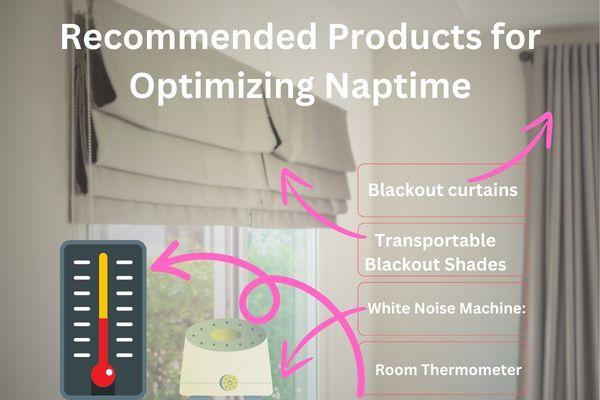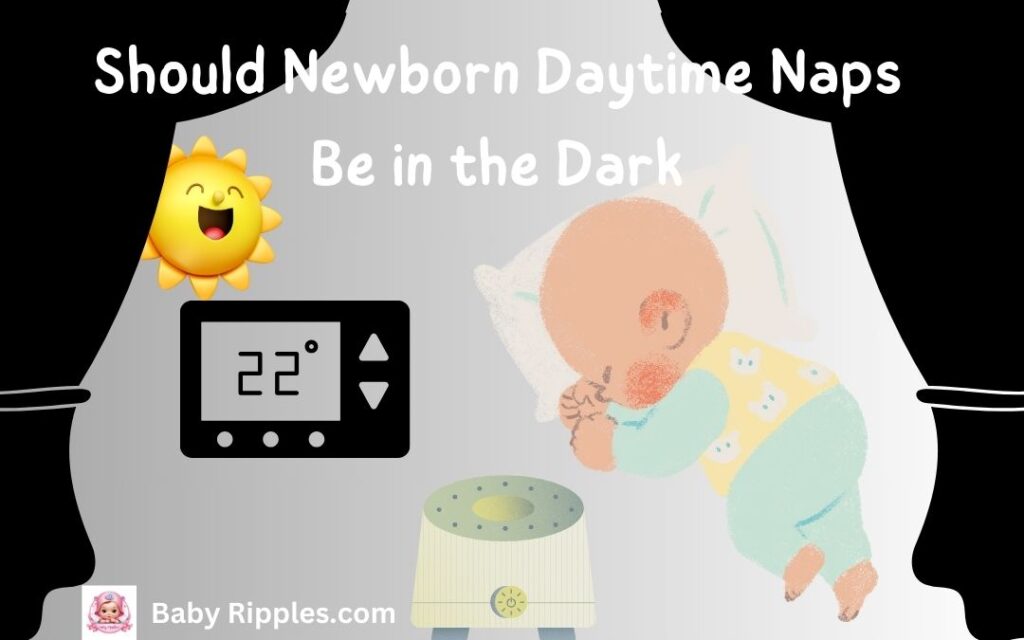One of the most difficult parts of early parenting is getting a newborn to sleep. You might be wondering should newborn daytime naps be in the dark to help them sleep better and ease your burden. The answer is: Yes, babies who are light sleepers or easily stimulated can benefit from having a darker nap area. A darker setting can encourage deeper, more peaceful naps by lowering visual distractions.You may also be wondering What to Dress Baby in for Sleep to ensure their comfort and safety in a darkened room, making nap time as soothing as possible.
This article addresses this crucial query and offers helpful advice on how to set up the ideal sleeping environment for your infant.
- Understanding Newborn Sleep Patterns
- Why Daytime Nap Environment Matters
- Benefits of Daytime Naps in the Dark
- Balancing Light and Dark for Newborn Daytime Naps
- Nap Schedule for 1 to 12 Months
- Creating the Ideal Naptime Environment: Step-by-Step Guide
- Key Takeaways: Should Newborn Daytime Naps Be in the Dark?
- Recommended Products for Optimizing Naptime
- Final Thoughts
- Frequently Asked Questions about should newborn daytime naps be in the dark
Understanding Newborn Sleep Patterns
Compared to older infants and kids, newborns sleep differently. Their sleep patterns don’t automatically correspond with day and night, and their naps from one to twelve months vary over time. Babies may sleep for shorter stretches of time during the day and night during the first few months, so it’s important to know how to create the ideal environment for their midday naps.
Why Daytime Nap Environment Matters
Newborns are not innately inclined to sleep longer at night or remain awake throughout the day since they do not yet have a fully developed circadian rhythm, also known as an internal clock. As kids get older, though, exposure to daylight during the day can aid in the establishment of this pattern, which will improve their quality of sleep at night. In order to help create a healthy nap pattern, this balance may make people wonder if they should take their naps during the day in a bright room or in the dark.
Benefits of Daytime Naps in the Dark

For some parents, a dark room for daytime naps feels like the best way to promote longer, more restful naps. Here are some reasons to consider darkening the room for your baby’s naps:
Reduces Visual Diversion
Infants are easily influenced by their surroundings. Daylight in particular can keep people up or interfere with their sleep. They can unwind and reduce visual distractions in a dark room.
Encourages More Restful Sleep
Rest is indicated by darkness. Dark nap environments can promote longer, undisturbed naps by simulating nighttime settings. Babies that are easily agitated or light sleepers would benefit from this.
Enhances the Quality of Sleep
Babies that consistently nap in dark environments are better able to recognize when it’s time to sleep. This can be particularly helpful for creating a nap pattern in which they link sleeping to darkness.
Effective in Sleep Training
If you’re sleep-training or attempting to establish a consistent one-nap routine as your child gets older, a dark room may be useful. Establishing a peaceful, dark environment aids in reinforcing the notion that naps are for sleeping.
Benefits of Light During Daytime Naps
There are also reasons why some parents choose to let their babies nap in natural daylight. Here’s how a brighter environment could be beneficial:
1. Encourages the Development of Circadian Rhythm
Babies who are exposed to natural light throughout the day are encouraged to synchronize their internal clocks, which aids in their learning of the distinction between day and night. Over time, this can lessen confusion between day and night.
2. Could Cut Down on Daytime Sleep
Your baby’s sleep at night may suffer if they take excessive naps throughout the day. Exposure to daylight during the day may promote longer periods of sleep at night and shorten naps.
3. A smoother awakening transition
Your infant can avoid grogginess by waking up naturally in an environment with plenty of light. In order to avoid interfering with their overnight sleep, it can be particularly helpful in the morning or early afternoon.
Balancing Light and Dark for Newborn Daytime Naps

It may take some trial and error to find the ideal ratio of light to dark for your newborn’s daytime naps. Here’s a methodical process to assist you in determining what works best:
1. Pay Attention to Your Infant’s Sleep Habits
If your baby seems easily overstimulated or naps shorter in light-filled spaces, consider darkening the room. • Pay attention to how long your baby naps and how well they sleep in various settings.
2. For babies that are overstimulated, try a dark room.
A dark room can provide a soothing environment for newborns who have trouble falling asleep or who act cranky during the day. Using a portable blackout curtain can be beneficial, particularly if you’re not at home or require flexibility with where you can take naps.
3. Allow for Light During Early and Late Naps
• Introducing natural light into your baby’s morning naps will help them wake up feeling more rested as they age older.
• If kids require more in-depth sleep, consider saving darker environments for their longest or midday naps.
4. Make Strategic Use of Light in the Afternoon
• Take afternoon naps in a room that is somewhat illuminated to prevent prolonged naps that disrupt your sleep at night. As babies develop, this balance enables them to set up their one nap pattern and obtain enough rest during the day.
Nap Schedule for 1 to 12 Months

Creating the Ideal Naptime Environment: Step-by-Step Guide
Here’s a simple guide to set up a nap-friendly environment that supports your baby’s sleep:
Step 1: Choose the Right Space
Choose a place where there aren’t many distractions. Some parents decide to keep their baby’s napping spot the same as their own nighttime sleeping spot. As newborns become accustomed to the space, a regular setting helps reinforce a nap routine from one to twelve months.
Step 2: Darken the Room
To regulate the amount of light, use blackout blinds or drapes. Consider a travel blackout cover that you can use over stroller windows, car seat windows, or even windows in a relative’s house for solutions that are portable or on-the-go. Babies sleep more easily in a dark environment because it lessens stimuli.
Step 3: Use White Noise
If your infant is sensitive to noise, a white noise machine can block out background sounds that could disrupt their sleep. White noise produces a calming background sound that might be useful whether your baby naps in a well-lit or gloomy environment.
Step 4: Control Temperature and Comfort
Cool, pleasant temperatures between 68 and 72°F (20 and 22°C) are ideal for newborns’ sleep. Steer clear of overdressing and think about wearing light, breathable layers.
Step 5: Establish a Sleep Schedule
Your baby will know it’s time to wind down if you have a regular pre-nap routine. A little song, a hug, or just some peaceful time could be part of this. A regular schedule helps children get used to taking naps during the day and prepares them for a restful sleep.
Key Takeaways: Should Newborn Daytime Naps Be in the Dark?
Deciding whether newborn daytime naps should be in the dark comes down to understanding what works best for your baby. In summary:
• Dark Room for Deeper Naps: If your infant is a light sleeper or overstimulated, darkening the room may help them have better naps.
• Natural Light for Rhythm Development: Light during naps can aid in developing a day-night cycle by assisting them in adjusting their internal clock.
• Pay attention and make adjustments: Some babies benefit most from a combination of longer naps in the dark and shorter naps with natural light exposure.
Recommended Products for Optimizing Naptime

Creating the ideal nap space for your baby can be easier with a few helpful products:
• Blackout curtains: Create a peaceful, dark space in your nursery.
• Transportable Blackout Shades: Ideal for on-the-go naps or travel.
• White Noise Machine: This device creates a calming atmosphere by drowning out outside noise.
• Room Thermometer: Assists in maintaining a constant temperature that is suitable for infants.
With the aid of these goods, you can confidently design a space that is ideal for your infant, enabling them to obtain the daytime sleep they require to promote a better night’s sleep.
Final Thoughts
Finding a solution that works best for you and your baby is the main objective, regardless of whether you decide to expose your newborn to light or darkness during their daily naps. Examine, test, and modify their nap settings according to their developmental stage and needs. You’ll soon establish a schedule that suits everyone, guaranteeing that you and your child get the good sleep you need.
Frequently Asked Questions about should newborn daytime naps be in the dark
1. Should newborn daytime naps be in the dark?
Yes, babies who are light sleepers or easily stimulated can benefit from having a darker nap area. A darker setting can encourage deeper, more peaceful naps by lowering visual distractions.
2. Will darkening the room for naps confuse my newborn’s day-night rhythm?
Not always. A healthy circadian rhythm can still be supported by exposing your infant to natural light in the morning and evening, even though darkness promotes longer naps. Depending on the time of day, think about alternating between naps in natural light and those in the dark.
3. When should I start using a nap schedule for my baby?
As your baby’s sleep becomes more consistent, you can begin establishing a nap plan as early as three months of age. But bear in mind that babies have erratic sleep patterns, so it might not be possible to establish a regular nap plan until they are a little older.
4. How can I tell if my baby needs a dark room to nap?
A dark environment could help your baby sleep better if they wake up a lot or seem overstimulated by light. Try trying both alternatives to determine which your infant prefers; some newborns do better in a brighter setting.
5. What are the best products to help create a dark naptime environment?
Parents frequently choose white noise machines, portable blackout blinds, and blackout curtains. These items contribute to the creation of a peaceful, dark environment that is perfect for longer, undisturbed slumber.





